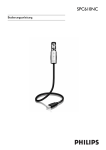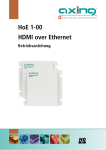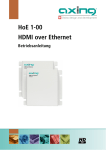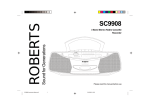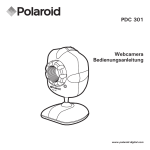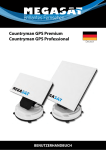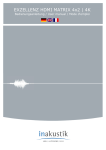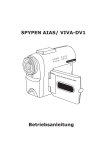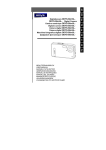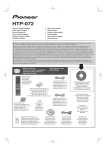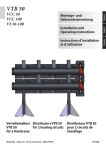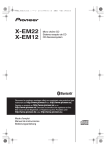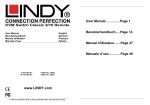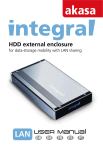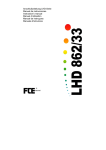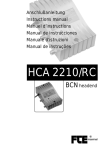Download HDMI over Ethernet Extender www.lindy.com
Transcript
HDMI over Ethernet Extender User Manual Benutzerhandbuch Manuel d’utilisateur Manuale d’uso No.38127 No.38128 English Deutsch Français Italiano Transmitter (TX) Receiver (RX) www.lindy.com Tested to Comply with FCC Standards For Home and Office Use! © LINDY Group - LINDY ELECTRONICS LIMITED & LINDY-ELEKTRONIK GMBH - FIRST EDITION (July 2013) User Manual English User Manual English Introduction Network Setup of TX and RX Extender units Thank you for purchasing the LINDY HDMI over Ethernet Extender. This HDMI Extender allows you to distribute an HDMI signal up to 1080p via Ethernet network to multiple displays for applications such as digital signage, public display and large scale presentations. With support for crystal-clear digital video, these extenders can take your distribution system to the next level. This setup has to be used if you are using 1-to-many or many-to-many configurations. These extenders convert the HDMI signal to IP broadcast signals. Network devices can be used to distribute the signals. These extenders support 1-to-1, 1-to-many and also many-to-many configurations, with the requirement of using managed network switches supporting broadcast protocols. Because of bandwidth requirements this video broadcasts should use their own dedicated network connections or should be used in a separate port based VLAN. Step 1: Assign the computer’s IP address, i.e. 192.168.168.11, through Control Panel, Network Connections, Local Area Connections, Status, Properties, Internet Protocol (TCP/IP). Press OK to save the configuration. Step 2: Turn on the Extender device to be configured. The red Power LED will light up, and after 10 seconds the green Status LED will also light up. At this time press the Reset button (about 5-10 seconds) until the green Status LED turns off. Features • • • • HDMI Extender TX and RX are setup via web browser. The default IP address of TX is 192.168.168.55 and of RX is 192.168.168.56. (This default IP address is always restored when resetting!) An individual IP address must be assigned to each unit, i.e. IP:192.168.168.XX (XX:1-255), Subnet mask 255.255.255.0, and MAC:00:0b:78:XX:XX-XX (XX:01-FF). HDMI signal extension through Ethernet Ability to cascade up to 3 layers of network switches HDMI with HDCP support, 480i up to 1080p60@8bit supported, not 3D capable Support for IR remote control back channel (IR: 940nm, 38kHz IR signals) Step 3: Use an Ethernet Cable to connect the computer and the device. The Status LED will flash in green. Step 4: Use a web browser to access the unit (TX:192.168.168.55, RX:192.168.168.56). Click the System menu and setup the required IP address, subnet mask, and MAC address as mentioned above. It is recommended to label the units with this setting. Package Contents • • • Transmitter (TX) No.38127 or Receiver (RX) No.38128 Multi Country Power Supply with 4 adapters for EURO, US, UK, AUS/CN This manual Step 5: Click Apply button, the green Status LED should turn off. Step 6: Turn off and disconnect the device. Installation 1. Before connecting any extender equipment please switch off all devices If you have any problems try to ping the connected device with the new IP address. You will receive the reply if the connection is established. Remember that every Reset restores the factory default values for IP address etc.! 2. Connect the HDMI display(s) to the Receiver(s) using HDMI cable 3. Connect the HDMI source(s) to the Transmitter(s) using HDMI cable Trouble Shooting 4. If required connect the IR transmitter cable(s) and IR receiver cable(s) to the Extender units and place them in appropriate position to the HDMI devices • Please only use HDTV/SDTV resolutions like 1080, 720, 576 and 480. Other resolutions may require to copy the monitor EDID data into the TX. 5. Connect the power supplies • Please check if all power LEDs are lit. Eventually exchange / replace the power supply • Please check if all cable connections are seated well • Please check if you can ping the extender units • IR support is limited to 38kHz signals, IR signals in other frequency ranges, i.e. several Sky receivers, are not supported • If you are not using a separated network, i.e. via VLAN configuration, your network may suffer from extremely high traffic causing certain network components to fail. If this is the case please contact an experienced network technician to set up your network • If you cannot locate the problem – and if it is NOT just a network problem – please contact LINDY support team. The worldwide contact information is available from the LINDY website. 1-to-many configuration with multiple Receivers (RX) / displays 6. Only use network switches that at least support port based VLAN management functions and the broadcast protocol as well. Configure your network switch so that a separate VLAN is used for the extender units. If your switch also allows you to define ports as OUTPUT or INPUT you may also use this function. (The web configuration page of the Extender units is not password protected and therefore open to any user!) 7. The IP and MAC address of the TX and RX units must be different. The units can be configured via web browser. Please refer to section Network Setup of TX and RX Many-to-many configuration with multiple TX and multiple RX 8. Configure your network switch so that functionally linked TX and RX each use a separate VLAN. 9. Connect your TX and RX Extenders to the network ports and power on all devices This procedure refers to firmware v.1.07. It is subject to change without notice. This procedure refers to firmware v.1.07. It is subject to change without notice. Handbuch Deutsch Einführung Mit dieser HDMI over Ethernet Extender-Serie können Sie HDMI-Signale bis 1080p über ein Ethernet-Netzwerk an eine Vielzahl von HDMI-Displays verteilen. Es ist ideal geeignet für Digital Signage, öffentliche Bildschirmanzeigen, Vorführ- und Videopräsentationen und immer, wenn kristallklare Bilder verteilt werden sollen. Dieses System stellt Ihr Präsentationssystem auf die nächsthöhere Ebene. Die Extender konvertieren das HDMI- in ein IP-Broadcast-Signal. Dieses kann mit Netzwerkgeräten (Switches, …) verteilt werden. Die Extender unterstützen Übertragungen in den Modi „1-an-1“, „1-an-Viele“ und „Viele-an-Viele“ , was die Verwendung von Netzwerkswitches mit Managementfunktionen und mit Unterstützung der Broadcast-Protokolle zwingend erfordert. Wegen der Bandbreitenanforderungen sollten diese Video-Broadcasts immer in einem eigenen oder per Port-based-VLAN abgeschlossenen Netz erfolgen. Eigenschaften • • • • HDMI Verteilsystem über Ethernet Möglichkeit zur Kaskadierung über 3 Ebenen mit Netzwerkswitches HDMI mit HDCP kompatibel, unterstützt 480i bis 1080p60@8 Bit, 3D nicht unterstützt Unterstützt Rückkanal für IR Fernbedienungssignale (IR: 940nm, 38kHz) Lieferumfang • • • Transmitter (TX) Art.-Nr. 38127 oder Receiver (RX) Art.-Nr.38128 Steckernetzteil mit 4 Adaptern für EURO, US, UK, AUS/CN Steckdosen Dieses Handbuch Installation 1. 2. 3. 4. Schalten Sie alle Geräte aus bevor Sie mit der Installation beginnen Verbinden Sie das/die HDMI Display(s) mit dem/n Receiver/n (RX) Verbinden Sie die HDMI Quelle(n) mit dem/n Transmitter/n (TX) Falls erforderlich, schließen Sie die IR Transmitter und IR-Receiverkabel an und positionieren Sie die Sender/Empfänger in der richtigen Position zu den Geräten 5. Schließen Sie die Netzteile an 1-an-Viele-Konfiguration mit mehreren Receivern (RX) und Displays 6. Verwenden Sie ausschließlich Netzwerk-Switches mit Unterstützung von Portbasiertem VLAN sowie für das Broadcast Protokoll! Konfigurieren Sie ihren Switch so, dass die Extender in einem separaten VLAN arbeiten. Falls Ihr Switch auch die Definition von INPUT- und OUTPUT-Ports erlaubt, können Sie dies optional verwenden. (HINWEIS: Die Web-Konfigurationsseiten der Extender sind nicht Passwort-geschützt und frei zugänglich für jeden User!) 7. IP- und MAC-Adressen der TX und RX müssen alle unterschiedlich sein; Sie werden per Web-Browser konfiguriert, siehe Abschnitt Netzwerkkonfiguration TX & RX Viele-an-Viele-Konfiguration mit mehreren RX und mehreren TX 8. Konfigurieren Sie Ihren Switch so, dass funktional verbundene TX und RX jeweils in einem eigenen abgeschlossenen VLAN arbeiten 9. Verbinden Sie die RX und TX mit dem Netzwerk und schalten Sie alles ein. Die Installationsanleitung bezieht sich auf den Stand v.1.07 – Es kann jederzeit ohne Ankündigung geändert werden Handbuch Deutsch Netzwerkkonfiguration TX & RX Diese Konfiguration ist für 1-an-Viele- und Viele-an-Viele-Verbindungen zwingend erforderlich. HDMI Extender TX und RX werden via Web Browser konfiguriert. Die Default IP-Adresse des TX ist 192.168.168.55 und die des RX ist 192.168.168.56. (Auf diese Default IP-Adresse wird bei jedem Reset wieder zurückgesetzt!) Jeder TX und RX benötigt eine individuelle IP-Adresse, z.B. IP:192.168.168.XX (XX:1-255), Subnetz-Maske 255.255.255.0, und MAC:00:0b:78:XX:XXXX (XX:01-FF). Schritt 1: Ändern Sie die IP Adresse des Computers z.B. auf 192.168.168.11, via: Systemsteuerung > Netzwerkverbindungen > LAN Verbindung >Eigenschaften > TCP/IP Protokoll > Eigenschaften > Folgende … verwenden. Drücken Sie OK zum Speichern. Schritt 2: Schalten Sie den zu konfigurierenden Extender-Unit ein, die Power LED leuchtet rot und nach ca. 10 Sekunden leuchtet die grüne Status LED. Drücken Sie nun den Reset-Taster, z.B. mit einer Büroklammer, etwa 5-10 Sekunden bis die grüne Status LED erlischt. Schritt 3: Verwenden Sie ein Patchkabel um den Extender an den Rechner anzuschließen – die Status LED sollte nun grün blinken. Schritt 4: Rufen Sie im Web Browser die IP Adresse des Extenders auf: TX:192.168.168.55, RX:192.168.168.56. Klicken Sie auf System und geben Sie die neue IP-Adresse, Subnetz Maske, und MAC Adresse ein wie oben vorgegeben. Schritt 5: Klicken Sie auf den Apply Button, die grüne Status LED sollte nun erlöschen. Schritt 6: Schalten Sie den Extender aus und ziehen Sie das Patchkabel ab. Um sicher zu gehen, dass die Extender-Unit korrekt erreichbar ist, können Sie vom WindowsEingabeprompt einen Ping Request absetzen. Beachten Sie aber die neue IP Adresse und die Tatsache, dass ein Reset wieder die Default IP Adresse setzt. Fehlersuche und -beseitigung • Verwenden Sie bitte nur HDTV/SDTV Auflösungen 1080, 720, 576 und 480. Andere Auflösungen erfordern möglicherweise das Kopieren der Monitor-EDID-Datei in den TX. • Prüfen Sie ob alle Power LEDs leuchten und tauschen/ersetzen Sie ggf. das Netzteil • Prüfen Sie alle Kabelverbindungen auf festen Sitz • Prüfen Sie ob der Extender auf einen Ping Request antwortet (s.o.) • IR Fernbedienungsunterstützung ist auf Fernbedienungen im am weitesten verbreiteten 38kHz Bereich beschränkt – Achtung: Manche Sky-Receiver verwenden andere Frequenzen • Falls Sie kein via VLAN abgetrenntes Netzwerk verwenden kann es zu Überlastungen im und Ausfällen Netz kommen. Falls dies der Fall ist lassen Sie ihr Netzwerk von einem erfahrenen Netzwerktechniker konfigurieren. • Falls Sie das Problem nicht lokalisieren können – und falls kein Netzwerkproblem vorliegt – kontaktieren Sie bitte den LINDY Support weltweit unter den auf LINDY.com angegebenen Kontaktadressen Die Installationsanleitung bezieht sich auf den Stand v.1.07 – Es kann jederzeit ohne Ankündigung geändert werden Manuel d‘utilisateur Français Introduction Avec cette série d’Extender HDMI over Ethernet LINDY, vous pouvez distribuer des signaux HDMI jusqu’au 1080p via un réseau Ethernet à une grande variété d’écrans HDMI. C’est une solution idéale en Digital Signage, les affichages publiques, vos présentations vidéo et à chaque fois que des images de qualités cristallines devront être distribuées. Ce système permettra d’élever votre installation au niveau supérieur Les extenders convertissent les signaux HDMI en signaux Broadcast IP, ce qui permettra de les distribuer au travers de périphériques réseau (switchs,…). Les extenders prennent en charge les transferts dans les modes « 1 :1 », « 1 vers plusieurs » et « plusieurs vers plusieurs », rendant nécessaire l’utilisation de commutateurs réseau avec des fonctions de management et la prise en charge des protocoles de Broadcast. Ces Broacasts vidéo devraient être, en raison des besoins de bande passante élevés, utilisés sur un réseau dédié ou dans une configuration réseau avec VLAN. Caractéristiques • • • • Système de distribution HDMI sur Ethernet Cascadable sur 3 niveaux avec switch Ethernet Compatible HDMI avec HDCP, prise en charge du 480i au 1080p60@8 bit, la 3D n’est pas prise en charge Prise en charge du canal de retour pour les signaux IR (IR : 940nm, 38kHz) Livraison • • • Emetteur (TX) N° Art. 38127 ou récepteur (RX) N° Art. 38128 Alimentation avec 4 adaptateurs EURO, US, UK, AUS/CN Ce manuel Installation 1. 2. 3. 4. 5. 6. 7. 8. 9. Eteignez tous les appareils avant de commencer l‘installation Connectez le(les) écran(s) HDMI avec le(les) récepteur(s) (RX) Connectez la(les) source(s) avec le(les) émetteur(s) (TX) Si requis, connectez les câbles transmetteur et récepteurs IR et positionnez les de façon adéquate par rapport aux appareils. Branchez les alimentations Configuration « 1 vers plusieurs » avec plusieurs récepteurs (RX) et écrans Utilisez exclusivement des switchs Ethernet avec des ports prenant en charge la fonction VLAN ainsi que le protocole Broadcast ! Configurez votre switch de tel manière que les extenders fonctionnent dans un VLAN dédié. Vous pourrez optionnellement utiliser la définition des ports INPUT et OUTPUT si votre switch le permet. Note : l’interface de configuration Web des extenders n’est pas protégée par mot de passe et est accessible à tous les utilisateurs ! Les adresses IP et MAC des TX et RX doivent toutes être différentes, elles sont configurables par navigateur Web, voir paragraphe Configuration réseau TX & RX. Configuration « plusieurs vers plusieurs » avec plusieurs TX et RX Configurez votre switch de tel manière que chaque TX et RX, reliés fonctionnellement, travaillent dans leur propre VLAN. Connectez les RX et TX avec le réseau et mettez le tout sous tension. Ces instructions se réfèrent au firmware v.1.07 et peuvent être modifiés à tout moment et sans préavis. Manuel utilisateur Français Configuration réseau TX & RX Cette configuration est obligatoire pour les liaisons « 1 vers plusieurs» et «plusieurs vers plusieurs». Les extenders HDMI TX et RX sont configurés via navigateur Web. L’adresse IP par défaut des TX est 192.168.168.55 et celle des RX est 192.168.168.56. (tout Reset remettra ces adresses IP par défaut !) Chaques TX et RX nécessitent une adresse IP individuelle, par exe. IP:192.168.168.XX (XX:1-255), masque de sous réseau 255.255.255.0, et MAC:00:0b:78:XX:XX-XX (XX:01-FF). Etape 1: changez l’adresse IP de l’ordinateur sur 192.168.168.11 par exemple, via: Panneau de configuration > afficher l’état et la gestion du réseau > connexion au réseau local >propriétés > TCP/IP version 4 > propriétés > rentrez l‘adresse. Cliquez sur OK pour enregistrer. Etape 2: Mettez l’unité extender à configurer sous tension, la LED Power s’allume en rouge et après 10 secondes la LED Status sera verte. Appuyez à présent sur le bouton Reset, avec un trombone par exemple, environ 5-10 secondes jusqu’à ce que la LED verte Status s’éteigne. Etape 3: Utilisez un câble réseau patch pour relier l’extender à l’ordinateur – la LED Status clignotera en vert. Etape 4: Entrez l’adresse IP de l’extender dans votre navigateur Web: TX:192.168.168.55, RX:192.168.168.56. Cliquez sur System et entrez la nouvelle adresse IP, masque de sous réseau,et adresse MAC comme spécifié ci-dessus. Etape 5: Cliquez sur Apply, la LED Status verte devrait s’éteindre. Etape 6: Mettez l’extender hors tension et déconnectez le câble patch. Pour vous assurez du bon paramétrage et de l’accessibilité de l’unité extender, vous pouvez faire une requête PING à l’aide de l’invite de commandes Windows. Notez tout de même qu’un reset remettra l’adresse IP par défaut. Recherche de panne et dépannage • • • • • • • Veuillez, s’il vous plait, n’utiliser que des résolutions HDTV/SDTV 1080, 720, 576 et 480. D’autres résolutions peuvent exiger la copie des données EDID de l’écran au TX. Vérifiez que toutes les LED Power s’allument et inverser/remplacer l’alimentation si nécessaire Vérifiez que tous les câbles soient bien connectés Testez la réponse à la requête PING de l’extender (voir ci-dessus) La prise en charge des télécommandes IR limité à celles les plus couramment utilisées dans la gamme de fréquence de 38kHz – Attention: certains récepteurs satelliteutilisent d’autres fréquences Si vous ne pouvez utiliser un réseau séparé via VLAN, une congestion ou des pannes réseau peuvent s’en suivre. Dans ce cas faites appel à un technicien réseau pour configurer votre équipement. Si vous ne pouvez localiser le problème, et s’il n’y a pas de problème au niveau de votre réseau, veuillez s’il vous plait prendre contact avec le support technique LINDY sous les adresses indiquées sur LINDY.com. Ces instructions se réfèrent au firmware v.1.07 et peuvent être modifiés à tout moment et sans préavis. Manuale d’uso Italiano Introduzione Manuale d’uso Italiano Configurazione di rete delle unità TX e RX Grazie per aver acquistato un Extender della serie HDMI over Ethernet LINDY. Questa linea di prodotti consente di distribuire segnali HDMI fino a 1080p su una rete Ethernet verso display multipli per applicazioni come Digital Signage, Monitor Pubblici e presentazioni su larga scala. Con il il supporto del video digitale di qualità Crystal-Clear la vostra distribuzione video raggiungerà livelli qualitativi superiori. Questi extender convertono il segnale HDMI in un segnale broadcast su IP. E’ possibile distribuire il segnale con normali apparati di rete e questa famiglia di prodotti consente di realizzare distribuzioni 1:1 (punto-punto), 1 a molti (punto-multipunto) e, se collegato a reti con switch “managed” con il supporto per trasmissioni broadcast, anche molti a molti. A causa dell’elevato consumo di banda conviene comunque utilizzare questi dispositivi su reti dedicate o su VLAN port based separate. Questa procedura è utilizzata se state utilizzando le configurazioni 1 a molti o molti a molti. Le unità TX e RX dell’Extender HDMI sono configurate con un browser web. L’indirizzo di default IP del TX è 192.168.168.55 mentre per l’RX è 192.168.168.56. (Questi indirizzi vengono sempre ripristinati dopo un Reset). Un indirizzo IP individuale va sempre assegnato ad ogni unità. Es. IP:192.168.168.XX (XX:1-255), Subnet mask 255.255.255.0, e MAC:00:0b:78:XX:XX-XX (XX:01-FF). Caratteristiche Step 2: Accendete l’extender da configurare. Il LED “Power” rosso di accenderà e dopo 10 secondi anche il il LED “Status” verde si accenderà. A questo punto premente il pulsante Reset (per circa 5-10 secondi) fino a quando il LED Status verde si spegne. • • • • Distribuzione del segnale HDMI su reti Ethernet Possibilità di cascata fino a 3 livelli di switch di rete Supporta segnali HDMI con HDCP, risoluzioni da 480i fino a 1080p60@8bit (NON supporta il 3D) Supporta back channel per ripetizione di telecomandi IR (IR: 940nm, frequenza 38kHz) Contenuto della confezione • • • Trasmettitore (TX) art.38127 oppure Ricevitore (RX) Art.38128 Alimentatore Multi Country con 4 adattatori per prese EURO, US, UK, AUS/CN Questo manuale Step 1: Assegnate un indirizzo IP al vostro computer incluso nella stessa sottorete degli extender (Es. 192.168.168.11) in Pannello di Controllo -> Connessioni di Rete -> Connessione alla rete locale -> Stato -> Proprietà -> Protocollo Internet (TCP/IP). Premete OK per salvare la configurazione. Step 3: Utilizzate un cavo Ethernet per collegare il PC al dispositivo. Il LED Status lampeggerà in verde. Step 4: Utilizzate un browser web per accedere all’apparato (indirizzo TX: 192.168.168.55, indirizzo RX: 192.168.168.56). Fate click sul menù System e modificate l’indirizzo IP, subnet mask, and MAC come richiesto dalla vostra installazione. Vi consigliamo di contrassegnare l’unità con queste impostazioni per facilitarne il controllo. Step 5: Fate Click sul pulsante Apply, dopo di che il LED verde Status dovrebbe spegnersi. Installazione 1. 2. 3. 4. Prima di tutto spegnete tutti I dispositive coinvolti nell’installazione Collegate i display HDMI ai moduli ricevitori (RX) utilizzando cavi HDMI standard Collegate le sorgenti HDMI ai moduli trasmettitori (TX) utilizzando cavi HDMI standard Se richiesto collegate i cavi dei trasmettitori IR e dei ricevitori IR collocandoli in modo da poter controllare correttamente gli apparati con i relativi telecomandi IR 5. Collegate gli alimentatori -> Configurazione 1 a molti con ricevitori (RX) e display multipli 6. Utilizzate solo switch che possano almeno gestire delle VLAN port based e la gestione dei protocolli di di trasmissione broadcast. Configurate il vostro switch in modo che le unità dell’extender si trovino su una VLAN dedicata. Se il vostro switch consente anche di configurare quali porte devono funzionare in Input e quali in Output fatelo pure.(la pagina web di configurazione degli extender non è protetta e quindi accessibile a qualsiasi utente!) 7. L’indirizzo IP e quello MAC di ciascuna unità degli extender devono essere differenti. Questi parametri sono configurabili nella pagina di configurazione delle singole unità. Per maggiori dettagli consultate la sezione Configurazione di rete delle unità TX e RX -> Configurazione molti a molti con trasmettitori (TX) e ricevitori (RX) multipli 6. Configurate il vostro switch di rete in modo che i gruppi di trasmissione (TX con tutti gli RX ad esso connesso) utilizzino delle VLAN separate. 7. Collegate le vostre unità TX e RX alle porte ethernet e accendete tutti i dispositivi Ces instructions se réfèrent au firmware v.1.07 et peuvent être modifiés à tout moment et sans préavis. Step 6:Spegnete e disconnettete il dispositivo. Se avete qualsiasi problema provate a fare un ping sul nuovo indirizzo IP. Se la connessione è correttamente stabilita riceverete risposta. Ricordate che dopo ogni Reset vengono ripristinati gli indirizzi assegnati in Fabbrica! Risoluzione dei problemi • • • • • • • Per favore utilizzate solo risoluzioni HDTV / SDTV come 1080, 720, 576 e 480. Altre risoluzione possono richiedere la copia del segnale EDID del monitor nell’unità TX. Per favore verificate se tutti i LED si accendono correttamente. Nel caso risultino spenti o attenuati provate (se possibile) a sostituire l’alimentatore. Controllate sempre che tutti connettori siano inseriti correttamente e a fondo. Controllate sempre che le unità dell’extender rispondano al ping. Il supporto per i telecomandi IR è limitato a 38kHz. I segnali inviati su frequenze differenti (per esempio quelli dei ricevitori SKY) non sono supportati Se non state utilizzando una rete dedicata (es. una VLAN) la vostra infrastruttura può risultare rallentata dall’elevato traffico generato dalle trasmissioni broadcast rendendo inaccessibili alcuni dispositivi. In questo caso contattate un tecnico specializzato per ottimizzare e configurare correttamente la vostra rete. Nel caso non riusciate ad identificare il problema e questo non è chiaramente un problema di rete potete contattare il Team di Supporto LINDY ai recapiti riportati sui siti nazionali LINDY. Ces instructions se réfèrent au firmware v.1.07 et peuvent être modifiés à tout moment et sans préavis. CE/FCC Statement Technical Specifications Operating Temperature Range Operating Humidity Range Supported HDMI Formats Video Output HDMI Transmission Distance Power consumption IR wave length & frequency Dimension (L×W×H) Net Weight TX (Transmitter Module) RX (Receiver Module) Recycling Information -5 to +35°C (+23 to +95°F) - use only in well-ventilated areas 5 to 90% RH (Non Condensing) – for inhouse use only SDTV/HDTV:480i/576i/480P/576P/720P/1080i/1080P Video Output HDMI, max 1080p, 8 bit, HDCP supported 1080P 8 bit 120m (Maximum) over direct Cat.5e/6 /24AWG/Solid Or 3 layers of network switches Power consumption TX: 3 watts; RX: 3 watts (Maximum) 940 nm, 38kHz 104 x 94 x 25 mm Receiver: ~220g,Transmitter: ~220g Default IP address: 192.168.168.55 MAC address: 00:0b:78:00:60:01 Default IP address: 192.168.168.56 MAC address: 00:0b:78:00:60:02 FCC Certification This equipment has been tested and found to comply with the limits for a Class B digital device, pursuant to part 15 of the FCC Rules. These limits are designed to provide reasonable protection against harmful interference in a residential installation. You are cautioned that changes or modification not expressly approved by the party responsible for compliance could void your authority to operate the equipment. Operation is subject to the following two conditions: 1. This device may not cause harmful interference, and 2. This device must accept any interference received, including interference that may cause undesired operation. CE Certification This equipment complies with the requirements relating to Electromagnetic Compatibility Standards EN55022/EN55024 and the further standards cited therein. It must be used with shielded cables only. It has been manufactured under the scope of RoHS compliance. WEEE (Waste of Electrical and Electronic Equipment), Recycling of Electronic Products Europe, United Kingdom In 2006 the European Union introduced regulations (WEEE) for the collection and recycling of all waste electrical and electronic equipment. It is no longer allowable to simply throw away electrical and electronic equipment. Instead, these products must enter the recycling process. Each individual EU member state has implemented the WEEE regulations into national law in slightly different ways. Please follow your national law when you want to dispose of any electrical or electronic products. More details can be obtained from your national WEEE recycling agency. Germany / Deutschland Die Europäische Union hat mit der WEEE Direktive Regelungen für die Verschrottung und das Recycling von Elektro- und Elektronikprodukten geschaffen. Diese wurden im Elektro- und Elektronikgerätegesetz – ElektroG in deutsches Recht umgesetzt. Dieses Gesetz verbietet das Entsorgen von entsprechenden, auch alten, Elektro- und Elektronikgeräten über die Hausmülltonne! Diese Geräte müssen den lokalen Sammelsystemen bzw. örtlichen Sammelstellen zugeführt werden! Dort werden sie kostenlos entgegen genommen. Die Kosten für den weiteren Recyclingprozess übernimmt die Gesamtheit der Gerätehersteller. France En 2006, l'union Européenne a introduit la nouvelle réglementation (DEEE) pour le recyclage de tout équipement électrique et électronique. Chaque Etat membre de l’ Union Européenne a mis en application la nouvelle réglementation DEEE de manières légèrement différentes. Veuillez suivre le décret d’application correspondant à l’élimination des déchets électriques ou électroniques de votre pays. Italy Nel 2006 l’unione europea ha introdotto regolamentazioni (WEEE) per la raccolta e il riciclo di apparecchi elettrici ed elettronici. Non è più consentito semplicemente gettare queste apparecchiature, devono essere riciclate. Ogni stato membro dell’ EU ha tramutato le direttive WEEE in leggi statali in varie misure. Fare riferimento alle leggi del proprio Stato quando si dispone di un apparecchio elettrico o elettronico. Per ulteriori dettagli fare riferimento alla direttiva WEEE sul riciclaggio del proprio Stato. CE Konformitätserklärung - Deutsch Dieses Produkt entspricht den einschlägigen EMV Richtlinien der EU für IT-Equipment und darf nur zusammen mit abgeschirmten Kabeln verwendet werden. Diese Geräte wurden unter Berücksichtigung der RoHS Vorgaben hergestellt. Die formelle Konformitätserklärung können wir Ihnen auf Anforderung zur Verfügung stellen LINDY Herstellergarantie – Hinweis für Kunden in Deutschland LINDY gewährt für dieses Produkt über die gesetzliche Regelung in Deutschland hinaus eine zweijährige Herstellergarantie ab Kaufdatum. Die detaillierten Bedingungen dieser Garantie finden Sie auf der LINDY Website aufgelistet bei den AGBs. LINDY No. 38127, 38128 1st Edition, July 2013 www.lindy.com Tested to Comply with FCC Standards For Home and Office Use!







